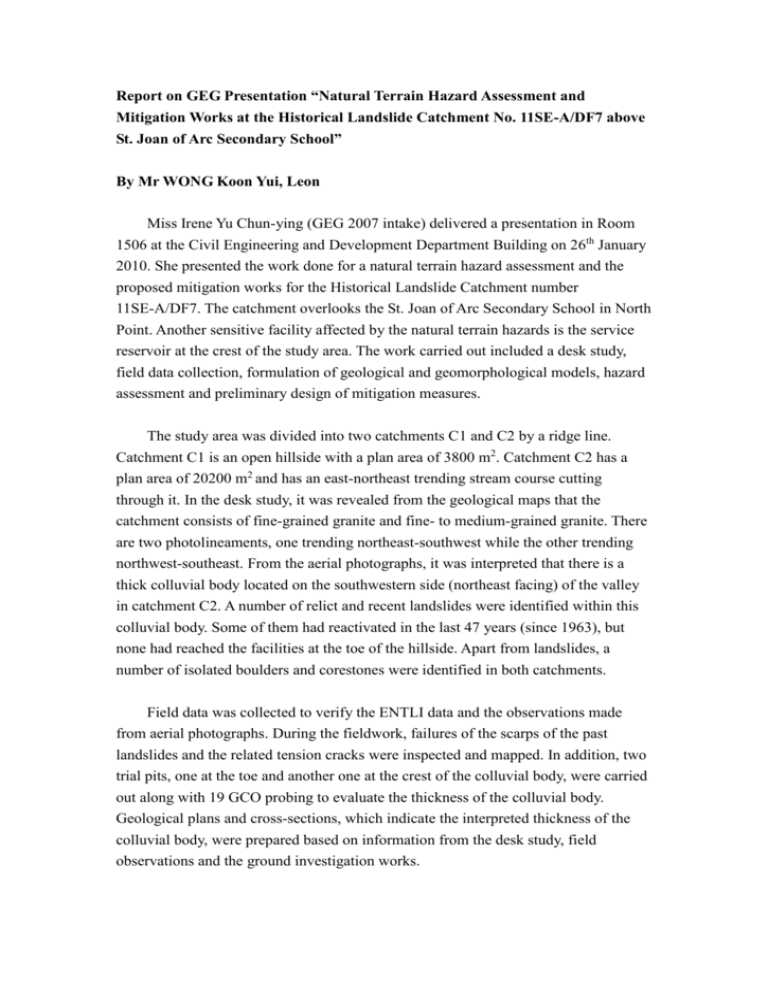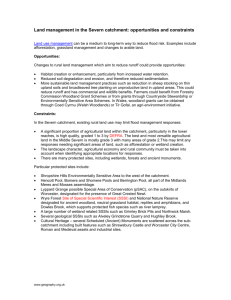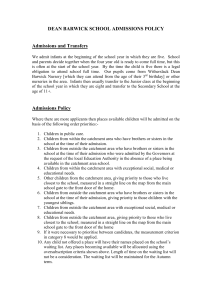Report on GEG Presentation “Natural Terrain Hazard Mitigation
advertisement

Report on GEG Presentation “Natural Terrain Hazard Assessment and Mitigation Works at the Historical Landslide Catchment No. 11SE-A/DF7 above St. Joan of Arc Secondary School” By Mr WONG Koon Yui, Leon Miss Irene Yu Chun-ying (GEG 2007 intake) delivered a presentation in Room 1506 at the Civil Engineering and Development Department Building on 26th January 2010. She presented the work done for a natural terrain hazard assessment and the proposed mitigation works for the Historical Landslide Catchment number 11SE-A/DF7. The catchment overlooks the St. Joan of Arc Secondary School in North Point. Another sensitive facility affected by the natural terrain hazards is the service reservoir at the crest of the study area. The work carried out included a desk study, field data collection, formulation of geological and geomorphological models, hazard assessment and preliminary design of mitigation measures. The study area was divided into two catchments C1 and C2 by a ridge line. Catchment C1 is an open hillside with a plan area of 3800 m2. Catchment C2 has a plan area of 20200 m2 and has an east-northeast trending stream course cutting through it. In the desk study, it was revealed from the geological maps that the catchment consists of fine-grained granite and fine- to medium-grained granite. There are two photolineaments, one trending northeast-southwest while the other trending northwest-southeast. From the aerial photographs, it was interpreted that there is a thick colluvial body located on the southwestern side (northeast facing) of the valley in catchment C2. A number of relict and recent landslides were identified within this colluvial body. Some of them had reactivated in the last 47 years (since 1963), but none had reached the facilities at the toe of the hillside. Apart from landslides, a number of isolated boulders and corestones were identified in both catchments. Field data was collected to verify the ENTLI data and the observations made from aerial photographs. During the fieldwork, failures of the scarps of the past landslides and the related tension cracks were inspected and mapped. In addition, two trial pits, one at the toe and another one at the crest of the colluvial body, were carried out along with 19 GCO probing to evaluate the thickness of the colluvial body. Geological plans and cross-sections, which indicate the interpreted thickness of the colluvial body, were prepared based on information from the desk study, field observations and the ground investigation works. Assessment of the hazards from the two catchments C1 and C2 was then carried out. It was concluded that the most possible hazard of catchment C1 is boulder fall, while the hazard of catchment C2 could comprise (i) open hillside failure (as revealed by the landslide history as well as the field mapping which identified tension cracks and re-activated failures of landslide scarps), and (ii) channelized debris flow due to the presence of the natural drainage line. Three possible source areas for channelized debris flow and open hillside failure in catchment C2 were identified, with an estimated surface area of 440m2, 490m2 and 500m2, respectively. After estimating the thickness of the possible failure mass using the information collected from the ground investigation, the source volumes of these possible landslides were then calculated. After identifying the landslide hazards, mitigation strategies were proposed to reduce the risk to an as low as reasonably acceptable level. For catchment C1, a flexible barrier is proposed at the toe of the catchment to protect the school from falling boulders. For catchment C2, three options were proposed. Option A includes the use of extensive soil nails to stabilize the colluvial body and a gabion fence at the slope toe to minimize the possibility of any landslide debris reaching the secondary school. In Option B, grillage beams are proposed instead of soil nails to stabilize the colluvial body in catchment C2, while in Option C, a gabion fence is proposed to deflect the landslide debris. After the presentation, a number of questions were raised concerning the origin of the large colluvial body and the reason why so many landslides occurred on the southwestern side of the valley in catchment C2 but not on the northeastern side. Miss Yu suggested that the regional jointing pattern might have a controlling effect on the rate of weathering of the rock mass in the area. This could have resulted in more landslides in the northeast facing slopes than the southwest facing slopes. It was also noted in the discussion that GEO Report No. 138 provides guidelines for conducting a natural terrain hazard assessment. In conclusion, the participants gained a better understanding of the approach and procedures for carrying out a natural terrain hazard assessment in this presentation.







